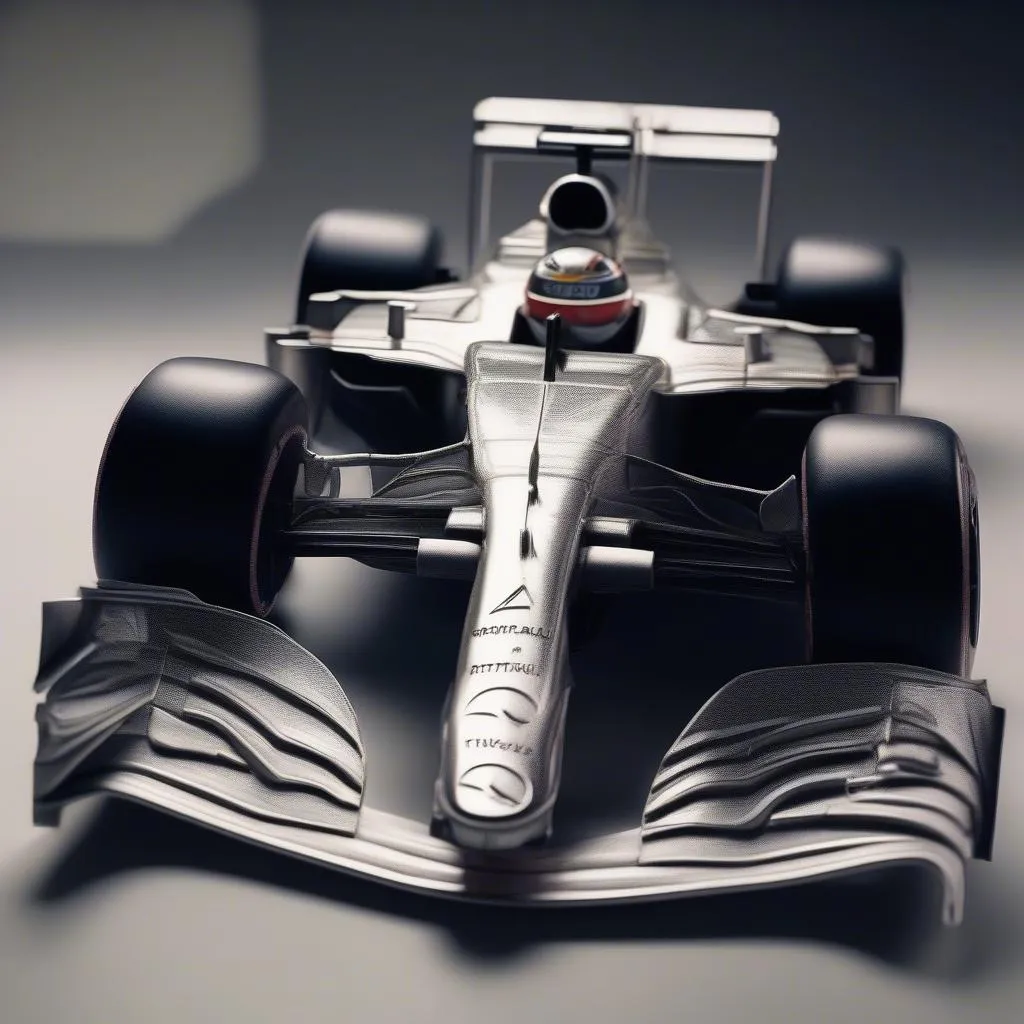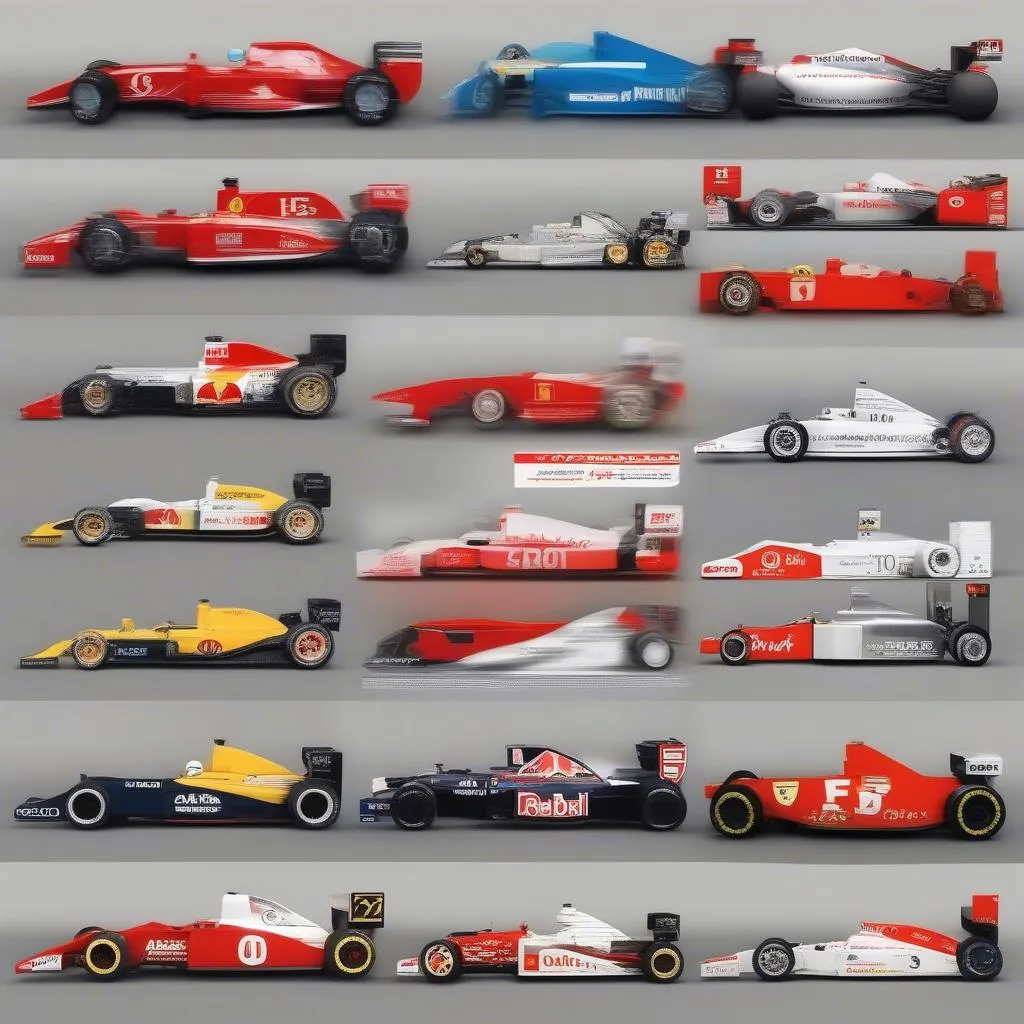Have you ever watched a Formula 1 race and been mesmerized by the sleek, powerful cars that zoom around the track at breakneck speeds? These machines are more than just vehicles; they’re technological marvels that represent the pinnacle of automotive engineering. But what exactly makes these cars so special? And what are some of the most iconic models in F1 history? Let’s dive into the world of F1 Car Models and discover the secrets behind their performance.
What are F1 Car Models?
The term “F1 car model” refers to the specific design and specifications of a Formula 1 race car. Think of it like the blueprint for a race car. Every F1 car model is unique, incorporating cutting-edge technologies, aerodynamic innovations, and powerful engines.
Think about it from the perspective of a mechanic – every car model is a puzzle that you need to understand to repair, maintain, or diagnose problems. For example, a 2023 Ferrari F1 car model is completely different from a 2010 Red Bull F1 car model, despite both being Formula 1 race cars. This is because of the constant evolution of technology and regulations in F1 racing.
Why Are F1 Car Models So Important?
F1 car models are important for several reasons:
Performance:
-
Aerodynamics: The design of an F1 car model is crucial to its aerodynamic performance. The cars are meticulously engineered to generate downforce and reduce drag, allowing them to corner at incredible speeds and achieve top speeds that are unmatched by any other vehicle.
-
Powertrain: F1 cars are equipped with high-performance engines that are capable of producing hundreds of horsepower. The engines are designed to be lightweight and efficient, allowing the cars to accelerate quickly and reach top speeds.
-
Lightweight materials: To achieve maximum performance, F1 cars are built using lightweight materials such as carbon fiber, titanium, and magnesium. These materials provide strength and stiffness while minimizing weight, resulting in a car that can handle cornering forces and brake with exceptional precision.
-
Driver interaction: The driver is an integral part of the F1 car model’s performance. The driver’s ability to control the car’s systems, such as the gearbox and traction control, is critical to achieving optimal lap times.
Innovation:
-
Technological advancement: F1 car models are a testbed for new technologies that often find their way into road cars. Over the years, F1 has pioneered the use of technologies like traction control, anti-lock brakes, and active suspension, which are now standard features in many production cars.
-
Engineering excellence: The development of F1 car models pushes the boundaries of automotive engineering. The teams involved in F1 are constantly striving to find new ways to improve performance, leading to significant advancements in areas like materials science, aerodynamics, and engine design.
Competition:
-
Global motorsport: F1 is a global sport, attracting millions of fans worldwide. The competitive nature of F1 racing drives teams to continually develop new and innovative car models, leading to an arms race of technological advancements.
-
Team strategy: F1 car models are often developed with specific driver characteristics and racing strategies in mind. This means that the team must carefully consider factors such as the driver’s experience, race track layout, and weather conditions when designing the car.
Iconic F1 Car Models:
Ferrari F2004:
- The Ferrari F2004, driven by Michael Schumacher, is considered one of the most dominant F1 cars of all time. This model dominated the 2004 season, securing 15 out of 18 victories.
Red Bull RB7:
- The Red Bull RB7, driven by Sebastian Vettel, was a formidable machine that helped Vettel achieve his first Formula 1 World Championship in 2010. It was a dominant force throughout the season and is considered one of the most successful F1 car models ever.
McLaren MP4/4:
- The McLaren MP4/4, driven by Alain Prost and Ayrton Senna, is widely regarded as one of the most successful F1 car models. It achieved 15 wins out of 16 races in the 1988 season, setting a record for most victories in a single Formula 1 season.
Williams FW14B:
- The Williams FW14B, driven by Nigel Mansell, introduced active suspension to Formula 1. The model was a dominant force in the 1992 season, winning 10 races and setting a record for most pole positions in a single season.
How to Learn More About F1 Car Models:
If you are interested in learning more about F1 car models, there are several resources available:
-
F1 websites: Websites like Formula1.com and Motorsport.com provide comprehensive information on F1 car models, including technical specifications, race results, and driver statistics.
-
F1 books: There are many excellent books available on F1 car models, such as “The F1 Car” by Giorgio Piola and “The Evolution of the Formula One Car” by Alan Henry.
-
F1 documentaries: Documentaries like “Senna” and “Formula 1: Drive to Survive” provide fascinating insights into the history and development of F1 car models.
Frequently Asked Questions About F1 Car Models:
What are the key differences between F1 Car Models from different eras?
F1 car models have evolved significantly over the years, with each era bringing new regulations and technological advancements. For example, older F1 cars from the 1960s and 1970s were often open-wheeled and featured powerful, naturally aspirated engines. Modern F1 cars, on the other hand, are highly aerodynamic, with closed cockpits and turbocharged hybrid engines.
How much does an F1 car model cost?
The cost of an F1 car model can vary significantly depending on the era, team, and condition. However, it’s safe to say that these cars are extremely expensive, with prices ranging from hundreds of thousands to millions of dollars.
What are some of the most important regulations governing F1 Car Models?
F1 regulations are designed to ensure safety, promote fair competition, and control costs. Some of the most important regulations include weight limits, engine size, fuel consumption, and aerodynamic specifications.
Can I buy an F1 car model to drive?
You can’t buy an F1 car model to drive on the road because they are not street-legal. However, you can buy scale models or replicas of F1 cars. These models are often highly detailed and make great collectors’ items.
 F1 car model scale
F1 car model scale
 F1 car model history
F1 car model history
Other Helpful Resources:
For more information on F1 car models and related topics, you can check out these articles on our website:
- F1 Car Scale Models: https://techcarusa.com/f1-car-scale-models/
- Diecast F1 Car: https://techcarusa.com/diecast-f1-car/
Conclusion:
F1 car models are a testament to the ingenuity and passion of automotive engineers and designers. These machines push the boundaries of performance and technology, offering a glimpse into the future of car development. If you’re a fan of racing or simply appreciate the beauty of engineering, F1 car models are a fascinating subject to explore.
Do you have any questions about F1 car models? Share your thoughts in the comments below! We’d love to hear from you!
Need help with diagnostics tools for European cars? We have a team of expert mechanics available 24/7 to assist you. Contact us via Whatsapp at +84767531508.